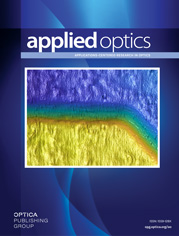Feature Issue of Applied Optics
Laser Applications to Chemical, Security and Environmental Analysis (LACSEA)
Submissions Open: 1 October 2018
Submission Deadline: 1 November 2018
Applied Optics welcomes submissions to a feature issue on "Laser Applications to Chemical, Security and Environmental Analysis (LACSEA)" in conjunction with the 2018 LACSEA Conference at the Imaging and Applied Optics Congress in Orlando, Florida, on 25-28 June 2018. Submissions of related papers that were not part of the 2018 LACSEA Conference also will be considered.
The further development of lasers and laser systems drives applications in optical sensing and analysis in various fields in industry, military, security, medicine, and chemistry. For analytical purposes in the field, laser sources need to be compact, rugged, tunable in wavelength, and of suitable power to provide data of sufficient quality for temperature, species composition, and velocity. Another consideration in laser-based analytical measurements is the speed with which data can be collected, which is limited—besides constraints in detector electronics—by the repetition rate and wavelength flexibility (if required) of the employed laser systems. Considerable progress has been made in recent years in high-repetition-rate pulsed laser systems with pulse energies in the hundreds of millijoule range that enable new approaches for temporally resolved measurements, even for methods with inherently low signal intensity.
This special issue is aimed at scientists, engineers, and practitioners interested in understanding the basic principles and diagnostic purposes of a variety of laser-based methods designed for the quantitative detection and monitoring of essential parameters in probed samples of different origin and aggregate state (i.e., gas, liquid, or solid). Its intent is to bring together the development areas of the necessary equipment (lasers, detectors, optics) as well as the methods themselves, and new approaches. The emphasis should be on applications of methods; however, theoretical discussion of both methods and data evaluation is also invited. The methods discussed in this feature issue must meet the requirement of being spectrally selective and provide sufficient detection sensitivity to optimize the performance for the application. There are numerous disciplines that are involved in the successful development of the various diagnostic methods. These include light sources and optical instrumentation, computational algorithms, and spectroscopy. They all contribute to defining the technique and its applications.
Topics of interest include, but are not limited to, the following areas:
- New technologies in laser sources for optical sensing applications: Continuous wave, pulsed, modulated lasers and their characterization; high-repetition-rate sources; broadband lasers; ultrafast lasers; frequency combs
- Chemical sensing methods: Spectroscopic sensing of gases, aerosols, and particulates; combustion, plasma, and industrial process monitoring; real-time control; energy topics; extension of techniques toward the VUV or THz spectral ranges; novel spectroscopic science; extension to multiple points or to volumetric measurements; high-repetition-rate imaging; sensor miniaturization; medical diagnostic
- Security applications: Remote sensing; miniaturization, optical lab-on-chip systems, and silicon photonics; distributed sensor networks; biochemical/biophysical applications of laser techniques; use of new sources offering high power or pulse energy; nonlinear optical techniques
- Computational, adaptive, and compressive imaging: Wavefront coding and coded aperture systems; multi-aperture imaging systems; plenoptic imaging systems and image processing; new imaging system demonstrations; joint optical-digital system design and optimization; applications of computational imaging
- Environmental analysis: Atmospheric sensing (concentration, vertical profile, flux, isotope ratio) of gases, solids, and liquids; atmospheric chemistry (smog chamber study and field campaign observation); advancements in LIDAR; extension and improvement of spectroscopic databases; airborne sensor systems; ruggedized sensor systems; propagation of laser beams through scattering media; air pollution and livestock emission
All papers need to present original, previously unpublished work and will be subject to the normal standards and peer review processes of the journal. The standard Applied Optics publication charges will apply to all published articles. To be eligible for publication, an expanded conference paper needs to add value to the original conference proceedings. Please see OSA's guidelines on expanded conference papers for details.
Manuscripts must be prepared according to the usual standards for submission to Applied Optics and must be uploaded through OSA's electronic submission system, specifying from the drop-down menu that the manuscript is for the Feature Issue on LACSEA 2018.
Feature Editors
Johannes Kiefer, University of Bremen, Germany (Lead Editor)
Weidong Chen, Université du Littoral, France
Thomas Dreier, University of Duisburg-Essen, Germany
Wolfgang Meier, German Aerospace Center, Germany
Thomas Seeger, University of Siegen, Germany
Hans Stauffer, Spectral Energies LLC, USA

